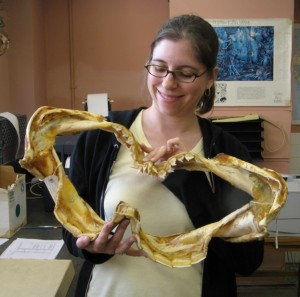Allegheny’s Whitenack featured on 2018 Shark Week
College to host previously aired ‘Megalodon: Fact vs. Fiction’
Throughout the 20th century, sharks have been a “cultural phenomenon” in the United States, according to an Aug. 11, 2014, ABC News article. A widespread panic swept the country after four New Jerseyans lost their lives during an attack in 1916, and ever since sharks have induced fear in the American public.

Television audiences have recently fixated on the “prehistoric monster” known as Megalodon. At 6:30 p.m. Monday, Sept. 3, in the Tippie Alumni Center, students are invited to a screening of “Megalodon: Fact vs. Fiction,” which aired July 27 during Discovery Channel’s annual Shark Week.
Matthew Ferrence, chair of the Allegheny College English Department and organizer of the screening, said it is important to highlight the work of scholars who continue to bring scientific programming to mainstream audiences.
Ever since that documentary aired, I’ve been getting the question … Is Megalodon still alive? I went to my son’s preschool to talk about sharks, and one of the kids asked me if Megalodon was still alive. It’s ridiculous.
— Lisa Whitenack, Associate professor of biology
Ferrence chose to share “Megalodon: Fact vs. Fiction” with Allegheny students for another reason — the program featured Lisa Whitenack, professor of biology, as one of six expert commentators.
The documentary reviewed the 2013 Shark Week program “Megalodon: The Monster Shark Lives,” which sought to prove the survival of a 60-foot ocean predator generally thought to be long extinct. The 2013 program, hosted by marine biologist Collin Drake, generated millions of viewers and left the public asking, could Megalodons still be living among us?
“Ever since that documentary aired, I’ve been getting the question … Is Megalodon still alive?” Whitenack said. “I went to my son’s preschool to talk about sharks, and one of the kids asked me if Megalodon was still alive. It’s ridiculous.”
Whitenack, along with her co-commentators on “Megalodon: Fact vs. Fiction,” said no. Throughout the documentary, the cast analyzed clips from “Megalodon: The Monster Shark Lives” and explained why each piece of evidence lacks factual credibility.
This summer marked the 30th anniversary of Shark Week, the longest running cable television programming event in history, according to a July 22 article. Like millions of people worldwide who are fascinated by this ocean-predator, Whitnack said she always loved to learn about sharks.
Growing up north of Chicago, Whitenack spent much of her leisure time outdoors.
“My grandmother had a house on a lake,” Whitenack said. “I spent a lot of time fishing with my dad, wandering around the woods and looking at (my grandmother’s) North American wildlife book from Readers Digest.”
But biology classes did not interest her in high school, so Whitenack completed her undergraduate degree in geology. As she veered away from biology in her early adulthood, she maintained a strong interest in sharks, a creature prominently displayed in the wildlife book owned by her grandmother.
“I’ve always loved sharks just as much as I’ve loved dinosaurs,” Whitenack said. “I started working on fossil sharks for my senior thesis as an undergrad at the University of Illinois, and when it came time to do my Ph.D., I decided to switch to a biology program to learn more about the animal (other) than rocks.”
While her senior thesis focused on shark fossils, Whitenack began working with living sharks and shark teeth at the University of South Florida during her doctorate program. Her current research focuses on functional morphology.
“The idea is organisms are shaped certain ways,” Whitenack said. “You can make some basic predictions about how organisms work from a mechanical standpoint based on their shape. … With sharks, about 95 percent of their fossil record is just teeth, so we make all these assumptions about their evolution and how they lived their lives based on their shape.”
Whitenack has studied sharks throughout their 400-million-year history. She said Megalodon draws a great deal of attention and fascination from the public, mainly because of its size compared to other prehistoric and present-day sharks.
“Megalodon kind of comes into my life a little bit just because I study teeth and how they work,” Whitenack said. “and that’s really (all) we have from Megalodon — teeth and a couple of vertebrae.”
Whitenack said she was chosen as a commentator on “Megalodon: Fact vs. Fiction” because of her expertise with shark teeth. Some pieces of evidence the cast examined were related to bite marks on whales captured by eyewitnesses.
For example, off the coast of Hawaii, a father and son said they discovered and filmed a whale carcass on the beach that “appeared to be bitten in half,” according to Drake. Because of the bite radius on the film and another picture allegedly taken by amateur photographers, it was portrayed as a possible Megalodon attack.
When Whitenack and her co-commentators took a closer look at the photograph, they noticed a number of inconsistencies, including bite marks that did not appear “ragged” enough to come from a Megalodon.
In the 2018 documentary, the cast members analyze more alleged bite marks, shipwrecks and other pieces of evidence from “Megalodon: The Monster Shark Lives” that created widespread speculation about the prehistoric creature.
“I was really pleased with how the entire experience went, especially after I saw the final product,” Whitenack said. “I got to sit there with my kids and some friends from the college and watch how it all turned out the night it aired.”
Ferrence suggested the college host a screening of “Megalodon: Fact vs. Fiction” to honor Whitenack’s work. He said Whitenack is an example of a reputable scientific scholar who is also an excellent communicator, which shows in the documentary.






